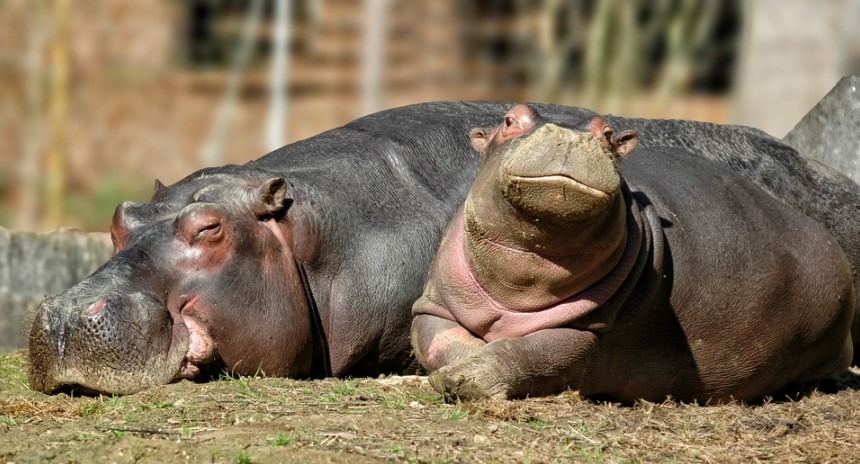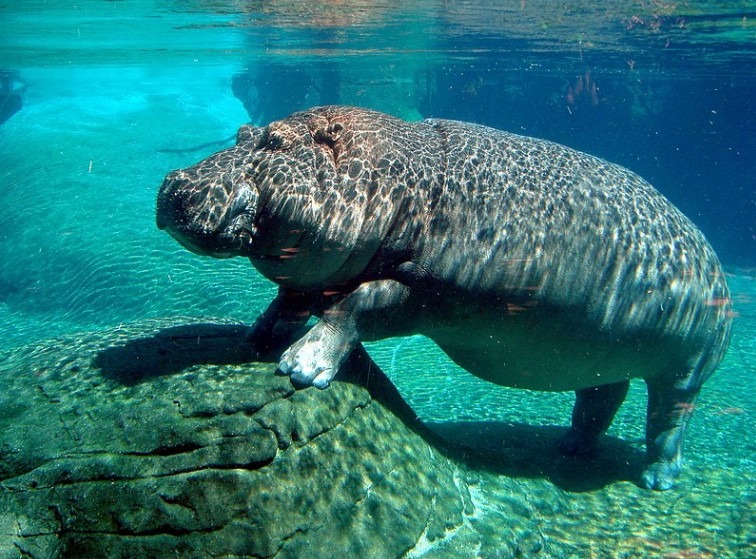With so much love for the water, the Hippopotamuses were called by Greeks as the “river horse” as love water, as they spend up to 16 hours a day submerged in rivers and lakes to keep their massive bodies cool under the hot African sun.
Hippos are real good swimmers, graceful in the water, and can hold their breath for up to five minutes. However, their size hinders them from simply walking or standing on the lake floor or lying in the shallows. With their eyes and nostrils high on their heads, they can see and breathe while mostly submerged.
There is a myth that hippos sweat blood.
However, the reddish fluid coming out from its skin is not sweat. For humans and most mammals, sweat is a way of cooling the body by releasing fluids out of the skin. However, the hippo secretes this red oily substance that acts as a skin moisturizer, water repellent, and antibiotic. The process is essential to hippos as they have a semi-aquatic nature and spend most of their time in the water.
Physical Characteristics
The hippopotamus has an enormous head, bulky body on stumpy legs, a short tail, having four toes on each foot. Males are larger sex, which usually 3.5 meters long and stand 1.5 meters tall, and they weigh a whopping 3, 200 kilograms. It has a 5-cm thick skin on the flanks but has thinner skin elsewhere, nearly hairless. It has a grayish color with pinkish underparts. It has a half a meter wide mouth that can gape 150° to show the teeth. It has sharp lower canines that may exceed 30 cm.
Hippos spend most of their lives in the water because they got easily dehydrated without periodic dips as their body loses water rapidly through their skin. They are well adapted to aquatic life as their eyes, nostrils, and ears are high on their heads while the rest of their bodies are submerged. They can also fold their ears and noses to keep out water when swimming. Their body is so dense that they can walk underwater. They must also drawback to the water to keep cool, for they do not sweat.
Behavior
Hippos prefer shallow areas where they can sleep while their bodies are half-submerged. During the dry season, a pool can become crowded with almost 150 of them. They embark on land during drought and famine, but they often cannot survive long dry seasons.
Walking along familiar paths by night, they reach nearly 10 kilometers into surrounding grasslands to feed for five or six hours. Hippo grasps grass with its wide lips, and jerk its head. Grazing and trampling are heaviest near the river that sometimes results in erosion because large areas are denuded of all grass.
Despite their huge size, they only eat relatively little vegetation because they have low energy requirements as they are only buoyed in warm water much of the time.
Unlike other herbivore mammals, a hippo does not chew the cud but retain food for a long time in the stomach. Protein will then be extracted through fermentation. It has a digestive process that cycles great quantities of nutrients into the African rivers and lakes. Thus, supporting fishes that are crucial protein source in the diet of the local people. How about the long canines and incisors? Hippos strictly use them as weapons.
Weighing almost three tons, you might think they hippos find it hard to catch their prey, nor run away from predators. But No. They may appear fat and slow, but they can run at 30 km/h on land. It can run so fast despite being the third-largest mammal on earth. Hippos can only accelerate their speed on flat ground. Their step is like a gallop but not lifting all four feet altogether. They neither have incredible stamina as they can only run at 30 km/h for around half a minute, maybe less.
Hippos actually cannot swim but can walk about 8 km underwater, gasping some air on the surface every few minutes. Then it will submerge again and walk some more. These giants can’t jump and finds difficulty in walking uphill.
A hippo can be on its top speed in just a couple of seconds and usually catch other animals or people by surprise. They are very territorial animals, and anyone who stands between them and the water will be charged. More people have not escaped from them than any other African mammal.
Related Links:
https://www.nationalgeographic.com/animals/mammals/h/hippopotamus/
https://herebeanswers.com/2009/11/hippopotamus-and-its-pink-colored-sweat.html
https://www.britannica.com/animal/hippopotamus-mammal-species

